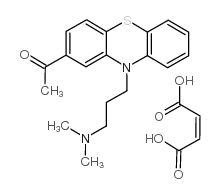Acepromazine maleate

Acepromazine maleate structure
|
Common Name | Acepromazine maleate | ||
|---|---|---|---|---|
| CAS Number | 3598-37-6 | Molecular Weight | 442.52800 | |
| Density | 1.155g/cm3 | Boiling Point | 497ºC at 760 mmHg | |
| Molecular Formula | C23H26N2O5S | Melting Point | 135-136ºC | |
| MSDS | USA | Flash Point | 254.4ºC | |
| Symbol |

GHS07 |
Signal Word | Warning | |
|
The in vitro and in vivo profile of aclidinium bromide in comparison with glycopyrronium bromide.
Pulm. Pharmacol. Ther. 28(2) , 114-21, (2014) This study characterised the in vitro and in vivo profiles of two novel long-acting muscarinic antagonists, aclidinium bromide and glycopyrronium bromide, using tiotropium bromide and ipratropium bromide as comparators. All four antagonists had high affinity ... |
|
|
Determination of 15 sedative residues in mutton by rapid resolution liquid chromatography-tandem mass spectrometry.
J. Sci. Food Agric. 95(3) , 598-606, (2015) The use of xenobiotic compounds in animal husbandry has given rise to consumer anxieties regarding residual risk and food safety. Thus, animal tissues have become main samples for residue analysis and food safety for sedatives. In this study, a rapid resoluti... |
|
|
Development and in-vivo evaluation of ondansetron gels for transdermal delivery.
Drug Dev. Ind. Pharm. 41 , 1030-6, (2015) Nausea and vomiting are some of the major side effects caused by certain drug therapies, e.g. chemotherapy, radiotherapy and general anesthesia. Because of the nature of the symptoms, oral delivery is inappropriate, while intravenous administration may be unp... |
|
|
Effect of doxycycline on contralateral canine cranial cruciate ligament rupture. A prospective randomized clinical trial in 69 dogs.
Vet. Comp. Orthop. Traumatol. 28 , 371-8, (2015) To evaluate whether doxycycline administered to dogs with unilateral cranial cruciate ligament rupture (Uni-CCLR) would decrease the risk of contralateral-CCLR (Co-CCLR). To evaluate predictors for Co-CCLR survival. To evaluate if a predisposition of Labrador... |
|
|
Experimental dog model for assessment of fasting and postprandial fatty acid metabolism: pitfalls and feasibility.
Lab. Anim. 49 , 228-40, (2015) The dog is a widely-used model for conducting metabolic studies. This is mainly due to its large size and its physiology which is relatively similar to that of humans. Here, we attempted to optimize a postprandial metabolic study protocol used in dogs. Follow... |
|
|
Modest hyperglycemia prevents interstitial dispersion of insulin in skeletal muscle.
Metab. Clin. Exp. 64(2) , 330-7, (2015) Insulin injected directly into skeletal muscle diffuses rapidly through the interstitial space to cause glucose uptake, but this is blocked in insulin resistance. As glucotoxicity is associated with endothelial dysfunction, the observed hyperglycemia in diet-... |
|
|
Assessment of xylazine for euthanasia of anoles (Anolis carolinensis and Anolis distichus).
J. Am. Assoc. Lab. Anim. Sci. 51(1) , 83-7, (2012) Intracoelomic (IC) injection of xylazine was evaluated as a chemical euthanasia method for Anolis lizards (Anolis carolinensis or Anolis distichus). Lizards were allocated into 5 groups of 10 animals each. Each group was euthanized by one of these methods: 10... |
|
|
[Severe meprobamate poisoning: description of 146 cases in a French department].
Therapie. 67(2) , 183-9, (2012) Meprobamate poisoning are serious and sometimes fatal. Faced with a potential stop of marketing, we conducted a multicenter retrospective study to assess the severity criteria presented by patients admitted to the ICU for severe meprobamate poisoning, whether... |
|
|
Clinical efficacy of sustained-release buprenorphine with meloxicam for postoperative analgesia in beagle dogs undergoing ovariohysterectomy.
J. Am. Assoc. Lab. Anim. Sci. 53(5) , 494-501, (2014) The goal of the current study was to compare the efficacy, adverse effects, and plasma buprenorphine concentrations of sustained-release buprenorphine (SRB) and buprenorphine after subcutaneous administration in dogs undergoing ovariohysterectomy. In a prospe... |
|
|
Dose regimens, variability, and complications associated with using repeat-bolus dosing to extend a surgical plane of anesthesia in laboratory mice.
J. Am. Assoc. Lab. Anim. Sci. 53(6) , 684-91, (2015) Extending a surgical plane of anesthesia in mice by using injectable anesthetics typically is accomplished by repeat-bolus dosing. We compared the safety and efficacy of redosing protocols administered either during an anesthetic surgical plane (maintaining a... |